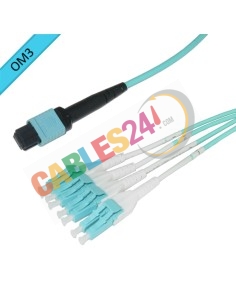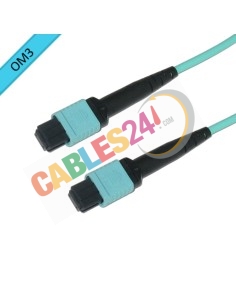- 6850 views
- 0 comments
MTP/MPO Polarity
In today's professional structured cabling networks, 12-fiber MTP/MPO cables are frequently used to connect equipment due to their small size and high versatility. The objective is to link the transmit signal (Tx) at a switch port to the corresponding receive signal (Rx), this characteristic is called polarity. Unlike traditional fiber optic duplex cables - patched LC or SC, with a Tx and Rx connector at each end - 12-fiber MTP cables bundle 12 fibers in a single MPO connector, making polarity management more complex. According to TIA standards, there are three types of polarity: type A, type B and type C. Different types of polarity cables can have different applications. We will mainly introduce MTP type B polarity cables and their applications.
General information about MTP/MPO cable with Type-A, Type-B and Type-C Polarities
Type-A cable is the second standard for polarity, and extremely versatile. This cable assembly can be used to connect directly between 40G QSFP+ optical transceivers, so it is commonly referred to as QSFP/QSFP+ direct connect cable or 40GBASE-SR4. As you can see from the diagram, this cable has a "straight" polarity and will result in a Pin 1 to Pin 12 ratio. This is very useful because 40G optics use parallel optics, i.e. instead of alternating Tx and Rx in a double-sided pattern, the port will look like the diagram below.
Often referred to as a 40G MTP cable, the Type B cable is the second standard for polarity, and extremely versatile. This cable assembly can be used to connect directly between 40G QSFP+ optical transceivers, so it is commonly referred to as a QSFP/QSFP+ direct connect cable or 40GBASE-SR4. As you can see from the diagram, this cable has a "crossed" polarity and will result in a Pin 1 to Pin 12 ratio. This is very useful because 40G optics use parallel optics, i.e. instead of alternating Tx and Rx in a double-sided pattern, the port will look like the diagram below.
Often referred to as a 40G MTP cable, the Type C cable is the third standard for polarity, and extremely versatile. This cable assembly can be used to connect directly between 40G QSFP+ optical transceivers, so it is commonly referred to as a QSFP/QSFP+ direct connect cable or 40GBASE-SR4. As you can see from the diagram, this cable has a "cross-pair" polarity and will result in a Pin 1 to Pin 12 ratio. This is very useful because 40G optics use parallel optics, i.e. instead of alternating Tx and Rx in a double-sided pattern, the port will look like the diagram below.
Most 40G fiber optic networks do not require perfect port symmetry: any Tx can go to any Rx. This means that fiber 12 can interact with fiber 1, because it is Tx and Rx inserted in the same connector, but at the other end.
MTP Cable Types with Polarity A, B and C
12-fiber MTP/MPO cable and MTP/MPO to 4xDuplex LC cable are the most commonly used in data centers. The genders of MTP/MPO are divided into male and female. Therefore, in terms of MTP trunk cable, there are three types of combinations: female-to-female, female-to-male and male-to-male. For 4xDuplex LC cable, there are also available with MTP/MPO Male-Female cable. The most commonly used are the MTP/MPO Female connectors.
MTP/MPO cable applications
Since MTP/MPO cables have male and female, 1 male and 1 female are required to be interconnected. The male guide pins fit into the female holes to ensure precise fiber alignment. The structure of the male and female connectors means that connection between those of the same gender cannot occur without signal loss or damage to the connector itself. In the case of opposite gender, a simple adapter or adapter panel is needed to align them perfectly without substantial signal loss.
Optimal for 40G QSFP+ application, type A, B and C polarity cables are becoming more and more popular than before in data centers. Cables24.com offers a complete range of MTP/MPO type cable solutions, please contact us.



























Comments (0)